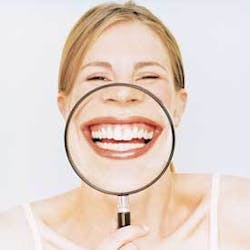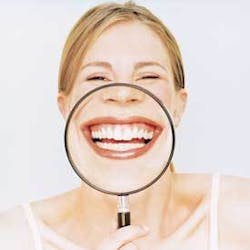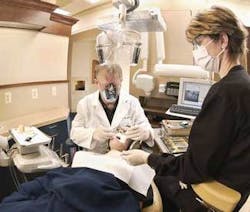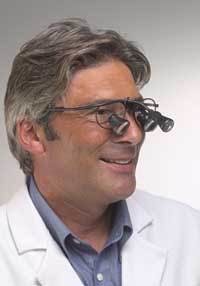Vision enhancement in the operatory
Allow yourself to provide better care and care for yourself better.
Ninety-nine percent of dental diagnosis is visual. You can’t diagnose what you can’t see. You can’t treat it if you can’t see it. You can’t produce the highest quality dentistry if you can’t see what you’re doing. Dental and vision experts universally agree that magnification and good lighting help you see better, provide better patient care, and produce higher quality dentistry. Where they have differed historically is about what kind of magnification and lighting is best.
Now there are some definitive findings about vision enhancement, which take into consideration comfort, ergonomics, and fatigue, that this article details. In the final analysis, you can definitely improve your vision and reduce fatigue by determining the combination of magnification and lighting that fits your specific needs, but you have to do the research, try the products, and learn new techniques. You have to be prepared to change, explore new possibilities, and endure the learning curves if you want to improve your physical health, vision, and quality of care. Determining the best vision enhancement for your specific needs is kind of like getting in shape; you can talk about it ad nauseam, but you won’t see results until your own sweat spills.
Vision fitness is highly personal. Only you can read the eye chart, have your eyes examined, and obtain a prescription that optimizes your vision. Don’t delegate the task to colleagues or vendors. Only you can judge the best magnification and lighting prescription for your needs. This article will inspire you with possibilities, provide guidelines for conducting research, and update you about lighting and vision concerns and technologies.
Light
Ambient light and operating light affect vision and endurance. Standards for ambient light have changed over time as dentists consider their clinical needs as well as their patients’ comfort. For example, many dentists have moved away from lighting their operatories with rows of fluorescent tubes, because it is not only uncomfortable for patients when their eyes are flooded with bright light when supine, but it is also ineffective to light 100 square feet of space to provide light to the oral cavity, an area measuring less than 4 percent of that space. Reducing ambient light outside the mouth region is more comfortable for patients and clinicians. A famous lighting study (http://ergo.human.cornell.edu/lighting/lilstudy/lilstudy.htm) published by Cornell University proved that indirect light reflected off a luminous surface (i.e., the ceiling) was healthier and more comfortable.
Dr. David Ahearn, who practices in Massachusetts and heads Design Ergonomics (www.desergo.com), a dental office design firm, says, “Traditional rules of thumb that the luminosity ratio of operating light to ambient light should be 3:1 to 5:1 are impractical to achieve and obsolete. When traditional operating lights emerged in the 1920s with big reflectors to focus inefficient incandescent bulbs that produced around 1,000 foot candles, you would need about 300 to 500 foot candles of ambient light to satisfy this ratio. Applying these ratios to today’s operating lights that produce 3,000 foot candles means having ambient light of at least 1,000 foot candles, which would create a room so bright that nobody would want to be in the room.”
While there is not an abundance of in-depth research about ambient and operating light levels, there is plenty of anecdotal information that supports reduced ambient light levels. Some dentists work without an operating light and use only a headlight where there is a substantial difference between ambient and operating light levels.
Dr. Gordon Christensen doesn’t believe that light level differences are a problem: “It’s like driving a car at night. You can see the road ahead without fatigue.”
Supporting this view is B.J. Chang, PhD, president of Surgitel, a manufacturer of magnification and lighting for dentists: “Any kind of room lighting is fine as it is very easy for the eye to adapt in a matter of seconds from bright to dark light. For example, a change in the pupil’s diameter from 1 mm to 2 mm will accommodate a 425 percent change between task and ambient light levels. The eye is amazing in that it can accommodate a 6,000 percent change in light intensity from sunlight to starlight. A major source of eye fatigue is caused when light levels are too dark or too bright.”
The bottom line in the primary concern about ambient light is that it provides a comfortable setting for you and the patient.
See the light
Many dentists use additional light to augment the operating light. Fiber-optic handpiece lighting is a popular choice along with headlights. New technologies include Isolite (www.isolitesystems.com), which illuminates the oral cavity from within, and the TLC Technology Lighting Center (www.tlcdentist.com), which replaces the traditional operating light with a cold, glare-free fiber-optic operating light. Significant technological advances in headlights are making them more practical and powerful. Light sources have been greatly improved as metal halide lights have replaced halogen lights.
Mark Scheftner, director of sales and marketing at Orascoptic, says, “The Orascoptic LumenArc™ metal halide light source is extremely bright and supports a seven foot, thin, long fiber-optic cable (1.6 mm diameter) that weighs only 8.5 grams.”
The Daylite system from Designs for Vision has a 2.0 mm diameter fiber-optic cable that is, according to John Walsh, corporate vice-president, “three times brighter than other systems.”
Portable, battery-powered LED headlights have also improved greatly, and while not as bright as fiber-optic systems, they offer untethered operation.
Dr. Christensen comments, “The aggressive, well-organized dentist going from op to op may find that being tethered to a fiber-optic headlight is a limitation and may wish to consider a battery-operated LED headlight.”
It is important to evaluate the entire headlight system, which includes seven major items:
① Intensity of the light source
②Throughput of the fiber-optic cable
③ Performance of the optics
④ Portability
⑤ Color temperature and CRI (color rendering index)
⑥ Battery life (LED only)
⑦ Operator comfort
While it is helpful to know specifications, the bottom line about headlights is how they perform for your personal style of practice, which means that you need to evaluate the complete product under actual operating conditions.
Magnification
Magnification helps you see better and clearly identifies ways to improve the quality of dentistry. Numerous magnification options may be confusing at first, but there are some simple guidelines that allow you to see better immediately. Options available today are:
● Loupes (2.5X-5.0+X $600-$1,800)
● Surgical optical microscope ($16,000 and up)
● Surgical video microscope ($23,000 and up)
Loupes
It is critical that you use any form of magnification under consideration in an actual clinical setting. You can adapt almost instantly using low-magnification loupes, but other forms of magnification can take up to a year to become comfortable and productive. Many loupe vendors offer money-back satisfaction guarantees of at least a month to allow you to truly evaluate the product for your specific needs.
“Magnification, working distance, and angle of declination are three important attributes to consider,” says John Walsh at Designs for Vision. “Each loupe prescription is customized to the user’s eyes. If you use someone else’s prescription, you won’t get the best results.”
Dr. Gordon Christensen says that the use of loupes will continue to expand and that dentists should go with a relatively high-quality product that typically costs $1,000 to $1,500. He cautions, “Be careful about cleaning, because it’s not difficult to scratch them within a few months of use and reduce their performance.”
Mark Scheftner, director of sales and marketing at Orascoptic Research, clarifies and debunks magnification myths: “Get magnification because it will help you perform your job better. You are not going to damage your eyes. You can see the margins and detail. You don’t miss things that you otherwise miss.”
Remember that working distance and magnification are related, so it is better to place more emphasis on how a complete system works for your personal style of practice rather than purchase a product based on specifications. You may be happier with a particular system because it is brighter, the image area is more appropriate (greater magnification reduces the field of view), and the loupes are more comfortable than specifications would indicate.
“Be sure to get loupes that are comfortable and ergonomic because the potential for neck problems (C6 and C7 vertebrae) exists,” cautions B.J. Chang at Surgitel.
The bottom line is that good magnifying loupes reduce fatigue, improve posture, and enhance vision.
Surgical optical microscope
Surgical microscopes have increased in popularity during the past few years as dentists have become more aware of their potential. They have been most popular for endodontics, but they are also used for other procedures.
“Don’t be intimidated by the technology or the money. It’s a lifetime investment,” says Jeff Kopp, marketing director for Global Microscopes. “An advantage of the surgical microscope is ergonomics because you sit upright, put your arms on armrests, and do micro-movements with your hands.”
Surgical optical microscopes definitely have a place in dentistry, and one of the best ways to evaluate them is to take a one- or two-day course. The learning curve can be six months to a year, but the benefits are great.
“The surgical optical microscope augments vision, but only a few dentists, especially endodontists, are using it routinely. Currently, in fixed prosthodontics and operative dentistry, for example, 2.5X to 4.0X loupes are used by most dentists instead of a microscope. The trend toward use of a microscope in restorative dentistry is slow but definitely evident, particularly to finish preparations and restorations,” comments Dr. Christensen.
Surgical video microscope
Sitting upright and viewing the operating field on a monitor while you work is commonplace in many medical procedures and is now available for dentistry. MagnaVu, for example, offers a “heads-up” product that eliminates crouching, leaning, and placing yourself in unhealthy positions.
Don’t wait to improve your health and patient care
You should try magnification and better lighting immediately. Many vendors offer money-back guarantees. Consider purchasing your top two choices. Evaluate them in clinical practice for at least two weeks. Keep the winning product and return the loser for a full refund. Beware. Magnification and lighting can be as addicting as wearing prescription glasses every day. They help you see better and work more efficiently with less fatigue. Improve your life and your dentistry with better lighting and magnification. There is no reason to wait any longer.



